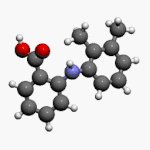Mefenamic acid
 | |
 | |
| Names | |
|---|---|
| Pronunciation | mef" e nam' ik[1] |
| Trade names | Ponstel, Ponstan, others |
IUPAC name
| |
| Clinical data | |
| Drug class | NSAIDs[1] |
| Main uses | Pain[1] |
| Side effects | Abdominal pain, heartburn, vomiting, kidney problems, fluid retention, rashes[2] |
| WHO AWaRe | UnlinkedWikibase error: ⧼unlinkedwikibase-error-statements-entity-not-set⧽ |
| Pregnancy category |
|
| Routes of use | By mouth, suppositories |
| Typical dose | 500 mg TID[3] |
| External links | |
| AHFS/Drugs.com | Monograph |
| MedlinePlus | a681028 |
| Legal | |
| Legal status | |
| Pharmacokinetics | |
| Bioavailability | 90% |
| Protein binding | >90% |
| Metabolism | Liver (CYP2C9) |
| Elimination half-life | 2 hours |
| Excretion | Urine (52–67%), faeces (20–25%) |
| Chemical and physical data | |
| Formula | C15H15NO2 |
| Molar mass | 241.290 g·mol−1 |
| 3D model (JSmol) | |
SMILES
| |
InChI
| |
Mefenamic acid is a nonsteroidal anti-inflammatory drugs (NSAIDs) used to treat mild to moderate pain including painful periods.[2][3] Other uses include for inflammation.[3] Such use is recommended for less than a week.[2] It is taken by mouth.[2]
Common side effects include abdominal pain, heartburn, vomiting, kidney problems, fluid retention, and rashes.[2] Other serious side effects may include cardiovascular disease, allergic reactions, stomach ulcers, hemolytic anemia, liver problems, and heart failure.[2][1][4] Use is not recommended in the last third of pregnancy and during breastfeeding.[2] Mefenamic acid works by decreasing the production of prostaglandin by the enzyme cyclooxygenase.[1]
Mefenamic acid was approved for medical use in the United States in 1967.[2] It is available as a generic medication.[3] In the United Kingdom 100 tablets of 250 mg costs the NHS about 23 pounds as of 2020.[3] This amount in the United States costs about 135 USD.[5] It is not widely used in the United States due to concerns of relatively greater side effects compared to some other NSAIDs.[1][4]
Medical uses
Mefenamic acid is used to treat pain and inflammation in rheumatoid arthritis and osteoarthritis, postoperative pain, acute pain including muscle and back pain, toothache and menstrual pain, as well as being prescribed for menorrhagia.[6][7][8]
There is evidence that supports the use of mefenamic acid for perimenstrual migraine headache prophylaxis, with treatment starting two days prior to the onset of flow or one day prior to the expected onset of the headache and continuing for the duration of menstruation.[9]
Mefenamic acid is recommended to be taken with food.[10]
Dosage
The typical dose is 500 mg three times per day in those over the age of 12 years.[3]
Side effects
Known mild side effects of mefenamic acid include headaches, nervousness, and vomiting. Potentially serious side effects may include diarrhea, gastrointestinal perforation, peptic ulcers, hematemesis (vomiting blood), skin reactions (rashes, itching, swelling; in rare cases toxic epidermal necrolysis) and rarely blood cell disorders such as agranulocytosis.[4][7] It has been associated with acute liver damage.[1]
In 2008 the US label was updated with a warning concerning a risk of premature closure of the ductus arteriosus in pregnancy.[11]
Contraindications
Mefenamic acid is contraindicated in people who have shown hypersensitivity reactions such as urticaria and asthma to this drug or to other NSAIDs (e.g. Aspirin); those with peptic ulcers or chronic inflammation of the gastrointestinal tract; those with kidney or liver disease; heart failure; after coronary artery bypass surgery; and during the third trimester of pregnancy.[7][12]
Overdose
Symptoms of overdosing include kidney failure, gastrointestinal problems, bleeding, rashes, confusion, hallucinations, vertigo, seizures, and loss of consciousness. It is treated with induction of vomiting, gastric lavage, bone char, and control of electrolytes and vital functions.[7]
Interactions
Interactions are broadly similar to those of other NSAIDs. Mefenamic acid interferes with the anti–blood clotting mechanism of Aspirin. It increases the blood thinning effects of warfarin and phenprocoumon because it displaces them from their plasma protein binding and increases their free concentrations in the bloodstream. It adds to the risk of gastrointestinal ulcera associated with corticosteroids and selective serotonin reuptake inhibitors. It can increase the risk for adverse effects of methotrexate and lithium by lowering their excretion via the kidneys. It can increase the kidney toxicity of ciclosporin and tacrolimus. Combination with antihypertensive drugs such as ACE inhibitors, sartans and diuretics can decrease their effectiveness as well as increase the risk for kidney toxicity.[7][8]
Pharmacology
Mechanism of action
Like other members of the anthranilic acid derivatives (or fenamate) class of NSAIDs, it inhibits both isoforms of the enzyme cyclooxygenase (COX-1 and COX-2). This prevents formation of prostaglandins,[1][13] which play a role in pain sensitivity, inflammation and fever, but also in hemostasis, kidney function, sustaining of pregnancy, and protection of the gastric mucosa.[14]
Pharmacokinetics

Mefenamic acid is rapidly absorbed from the gut and reaches highest concentrations in the blood plasma after one to four hours. When in the bloodstream, over 90% of the substance are bound to plasma proteins. It probably crosses the placenta, and is found in the breast milk in small amounts.[7][12]
It is metabolized by the liver enzyme CYP2C9 to the only weakly active 3'-hydroxymethylmefenamic acid. 3'-carboxymefenamic acid has also been identified as a metabolite, as well as carboxy glucuronides of all three substances. Mefenamic acid and its metabolites are excreted via the urine (52–67%) and the faeces (20–25%, or less than 20% following another source). The parent substance has a biological half-life of two hours; the half-life of its metabolites may be longer.[7][8][12]
History
Scientists led by Claude Winder from Parke-Davis invented mefenamic acid in 1961, along with fellow members of the class of anthranilic acid derivatives, flufenamic acid in 1963 and meclofenamate sodium in 1964.[15]: 718 Its name derives from its systematic name, dimethylphenylaminobenzoic acid. U.S. Patent 3,138,636 on the drug was issued in 1964.[16][17]: 918–919
It was approved in the UK in 1963 as Ponstan, in West Germany in 1964 as Ponalar and in France as Ponstyl, and the US in 1967 as Ponstel.[1][17]: 918–919
Society and culture
Availability and pricing
Mefenamic acid is generic and is available worldwide under many brand names.[18]
In the US, wholesale price of a week's supply of generic mefenamic acid has been quoted as $426.90 in 2014. Brand-name Ponstel is $571.70.[19] In contrast, in the UK, a weeks supply is £1.66, or £8.17 for branded Ponstan.[20] In the Philippines, 1 tablet of 500 mg generic mefenamic acid cost PHP25.00 (or the equivalent of US$0.50) as of September 2, 2019. In some other countries it is less expensive: for example, in Austria 30 tablets cost between €3.80 and €7.15 as of 2020.[21]
Synthesis
Analogous to fenamic acid, this compound may be made from 2-chlorobenzoic acid and 2,3-dimethylaniline.[22]
Research
While studies have been conducted to see if mefenamic acid can improve behavior in transgenic mouse models of Alzheimer's disease[23][24] there is no good evidence that mefenamic acid or other NSAIDs can treat or prevent Alzheimer's in humans; clinical trials of NSAIDs other than mefenamic acid for treatment of Alzheimer's have found more harm than benefit.[25][26][27]
See also
References
- 1 2 3 4 5 6 7 8 9 "Mefenamic Acid". LiverTox: Clinical and Research Information on Drug-Induced Liver Injury. National Institute of Diabetes and Digestive and Kidney Diseases. 2012. Archived from the original on 29 August 2021. Retrieved 8 October 2020.
- 1 2 3 4 5 6 7 8 "Mefenamic Acid Monograph for Professionals". Drugs.com. Archived from the original on 7 March 2021. Retrieved 8 October 2020.
- 1 2 3 4 5 6 BNF 79 : March 2020. London: Royal Pharmaceutical Society. 2020. p. 1182. ISBN 9780857113658.
- 1 2 3 Aronson, Jeffrey K. (2009). Meyler's Side Effects of Analgesics and Anti-inflammatory Drugs. Elsevier. p. 334. ISBN 978-0-08-093294-1. Archived from the original on 2021-10-09. Retrieved 2022-03-14.
- ↑ "Mefenamic Acid Prices, Coupons & Savings Tips". GoodRx. Archived from the original on 8 October 2021. Retrieved 8 October 2020.
- ↑ "Digital Medicines Information Suite". MedicinesComplete. doi:10.18578/bnf.855907230. Archived from the original on 2020-05-06. Retrieved 2020-04-18.
- 1 2 3 4 5 6 7 Austria-Codex (in German). Vienna: Österreichischer Apothekerverlag. 2020. Parkemed 500 mg-Filmtabletten.
{{cite book}}: CS1 maint: unrecognized language (link) - 1 2 3 "mediQ: Mefenaminsäure". Archived from the original on 2020-07-30. Retrieved 2020-07-23.
- ↑ Pringsheim T, Davenport WJ, Dodick D (April 2008). "Acute treatment and prevention of menstrually related migraine headache: evidence-based review". Neurology. 70 (17): 1555–63. doi:10.1212/01.wnl.0000310638.54698.36. PMID 18427072. S2CID 27966664.
- ↑ "Side effects for Mefenamic Acid". Medline Plus. National Institutes of Health. Archived from the original on 2016-07-05. Retrieved 2018-03-21.
- ↑ FDA March 2008 FDA advisory Archived 2017-01-12 at the Wayback Machine
- 1 2 3 Mefenamic Acid Monograph. Accessed 2020-07-22.
- ↑ Prusakiewicz JJ, Duggan KC, Rouzer CA, Marnett LJ (August 2009). "Differential sensitivity and mechanism of inhibition of COX-2 oxygenation of arachidonic acid and 2-arachidonoylglycerol by ibuprofen and mefenamic acid". Biochemistry. 48 (31): 7353–5. doi:10.1021/bi900999z. PMC 2720641. PMID 19603831.
- ↑ Mutschler, Ernst. Arzneimittelwirkungen. Wissenschaftliche Verlagsgesellschaft Stuttgart. pp. 205–206, 444. ISBN 978-3-8047-2898-1.
- ↑ Whitehouse M. Drugs to Treat Inflammation: A Historical Overview. pp 707-729 in Frontiers in Medicinal Chemistry, Volume 4. Eds Rahman A, et al. Bentham Science Publishers, 2009 ISBN 9781608052073
- ↑ "US Patent 3,138,636". Archived from the original on 2015-07-22. Retrieved 2015-07-04.
- 1 2 Marshall Sittig Pharmaceutical Manufacturing Encyclopedia Volume 1 A-K Archived 2007-10-23 at the Wayback Machine Second Edition, Reprint Edition. Noyes Publications, 1988
- ↑ Drugs.com drugs.com international listings for mefenamic acid Archived 2018-09-20 at the Wayback Machine Page accessed July 3, 2015
- ↑ Drugs for Osteoarthritis. The Medical Letter, 56(1450):80-84, September 2014
- ↑ https://www.medicinescomplete.com/mc/bnf/current/PHP6487-mefenamic-acid-non-proprietary.htm Archived 2021-08-28 at the Wayback Machine accessed 19th sept 2014
- ↑ Warenverzeichnis I & II. Österreichischer Apothekerverlag. June 2020.
- ↑ Trinus FP, Mokhort NA, Yagupol'skii LM, Fadeicheva AG, Danilenko VS, Ryabukha TK, Fialkov YA, Kirichek LM, Endel'man ÉS, Get'man GA (1977). "Mefenamic acid — A Nonsteroid Antiinflammatory Agent". Pharmaceutical Chemistry Journal. 11 (12): 1706–1711. doi:10.1007/BF00778304. S2CID 45211486.
- ↑ Joo Y, Kim HS, Woo RS, Park CH, Shin KY, Lee JP, Chang KA, Kim S, Suh YH (January 2006). "Mefenamic acid shows neuroprotective effects and improves cognitive impairment in in vitro and in vivo Alzheimer's disease models". Molecular Pharmacology. 69 (1): 76–84. doi:10.1124/mol.105.015206. PMID 16223958. S2CID 20982844.
- ↑ Daniels MJ, Rivers-Auty J, Schilling T, Spencer NG, Watremez W, Fasolino V, et al. (August 2016). "Fenamate NSAIDs inhibit the NLRP3 inflammasome and protect against Alzheimer's disease in rodent models". Nature Communications. 7: 12504. Bibcode:2016NatCo...712504D. doi:10.1038/ncomms12504. PMC 4987536. PMID 27509875.
- ↑ Miguel-Álvarez M, Santos-Lozano A, Sanchis-Gomar F, Fiuza-Luces C, Pareja-Galeano H, Garatachea N, Lucia A (February 2015). "Non-steroidal anti-inflammatory drugs as a treatment for Alzheimer's disease: a systematic review and meta-analysis of treatment effect". Drugs & Aging. 32 (2): 139–47. doi:10.1007/s40266-015-0239-z. PMID 25644018. S2CID 35357112.
- ↑ Jaturapatporn D, Isaac MG, McCleery J, Tabet N (February 2012). "Aspirin, steroidal and non-steroidal anti-inflammatory drugs for the treatment of Alzheimer's disease". The Cochrane Database of Systematic Reviews (2): CD006378. doi:10.1002/14651858.CD006378.pub2. PMID 22336816.
- ↑ Wang J, Tan L, Wang HF, Tan CC, Meng XF, Wang C, Tang SW, Yu JT (2015). "Anti-inflammatory drugs and risk of Alzheimer's disease: an updated systematic review and meta-analysis". Journal of Alzheimer's Disease. 44 (2): 385–96. doi:10.3233/JAD-141506. PMID 25227314.
External links
| Identifiers: |
|---|
- MedlinePlus Drug Information: Mefenamic Acid Archived 2008-10-01 at the Wayback Machine. Last accessed September 28, 2005.
- Ponstel Pharmacology, Pharmacokinetics, Studies, Metabolism - Mefenamic Acid - RxList Monographs. Last accessed September 28, 2005.